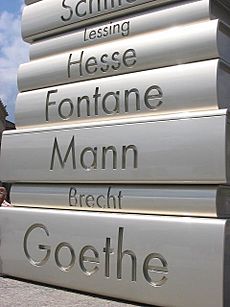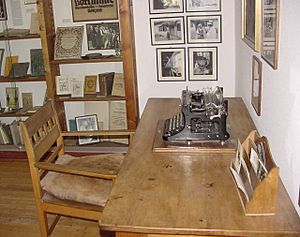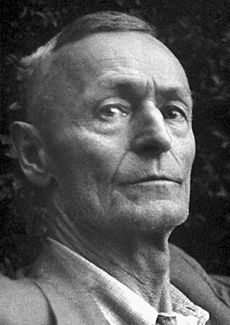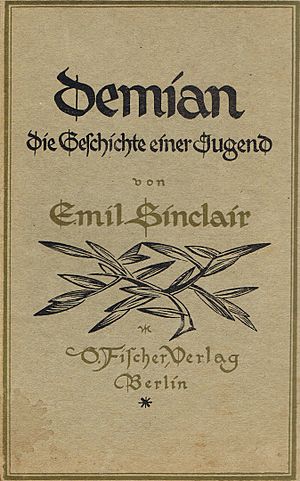Hermann Hesse facts for kids
Quick facts for kids
Hermann Hesse
|
|
|---|---|
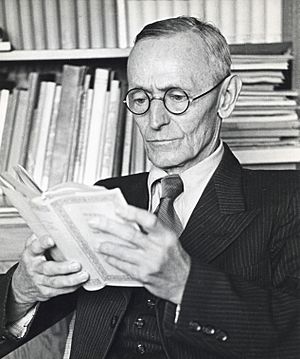 |
|
| Born | 2 July 1877 Calw, Oberamt Calw, Schwarzwaldkreis, Kingdom of Württemberg, German Empire |
| Died | 9 August 1962 (aged 85) Montagnola, Ticino, Switzerland |
| Resting place | Cimitero di S. Abbondio Gentilino, Ticino |
| Occupation | Novelist, short story author, essayist, poet, painter |
| Nationality | German |
| Citizenship | German, Swiss |
| Genre | Fiction |
| Notable works | The Glass Bead Game (1943) Siddhartha (1922) Steppenwolf (1927) Narcissus and Goldmund (1930) Demian (1919) |
| Notable awards |
|
| Signature | |
 |
|
Hermann Karl Hesse (German: [ˈhɛʁman ˈhɛsə]; born July 2, 1877 – died August 9, 1962) was a famous German-Swiss writer and painter. He wrote many novels, poems, and short stories.
Some of his most well-known books include Demian, Steppenwolf, Siddhartha, and The Glass Bead Game. These stories often explore a character's journey to find who they truly are and understand themselves better. In 1946, Hermann Hesse won the Nobel Prize in Literature, which is a very important award for writers.
Contents
Hermann Hesse's Life and Work
His Early Life
Hermann Karl Hesse was born on July 2, 1877, in Calw, a town in the Black Forest region of Germany. His family had a strong background in missionary work. His grandparents worked in India, helping to translate the Bible into the Malayalam language. His mother, Marie Gundert, was born in India.
Hesse's father, Johannes Hesse, was born in Estonia, which was then part of the Russian Empire. This meant Hermann was a citizen of both Germany and Russia when he was born. The Hesse family moved to Calw in 1873. His father worked for a publishing house that printed religious books.
Hesse grew up in a religious home. His father's stories about Estonia made young Hermann think about religion in a different way. He felt a bit different from others in his town. His grandmother, Julie Gundert, who was French-Swiss, also made him feel like a "citizen of the world."
His Childhood and School Days
From a young age, Hermann was very strong-willed. His mother once wrote about his "unbelievable strength" and "powerful will." He showed signs of being unhappy early in school.
Hesse wrote about his childhood in Calw in his stories, calling the town "Gerbersau." He described the river, the bridge, and the old houses. His favorite spot in Calw was the St. Nicholas Bridge. A statue of him was placed there in 2002.
Hermann's grandfather, who knew many languages, encouraged him to read a lot of books. This helped Hermann feel connected to the wider world. Both music and poetry were important in his family. His mother wrote poems, and his father was known for his sermons. By the age of 12 or 13, Hermann decided he wanted to be a writer.
In 1881, when Hermann was four, his family moved to Basel, Switzerland, for six years before returning to Calw. In 1891, he started at a religious school in Maulbronn Abbey. He did well at first, enjoying writing and translating Greek poetry. However, he soon felt rebellious. In March 1892, he ran away from the school.
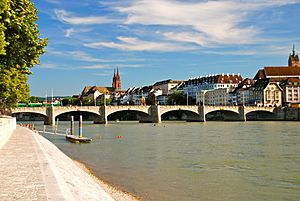
Hesse then went to different schools and institutions. He had many disagreements with his parents. In 1893, he finished his schooling. After this, he tried working in a bookshop, but quit quickly. Then he worked for 14 months at a clock factory in Calw. The work was boring, so he spent his time thinking about more creative things. In 1895, he started a new apprenticeship with a bookseller in Tübingen. He later wrote about these early experiences in his novel Beneath the Wheel.
Becoming a Writer
On October 17, 1895, Hesse began his bookselling job in Tübingen. The shop had many books on religion and languages. After working 12-hour days, Hesse would spend his evenings and Sundays reading and writing. He read works by famous writers like Goethe and Nietzsche. Nietzsche's ideas about passion and order greatly influenced his novels.
By 1898, Hesse was earning enough money to live on his own. He focused on German Romantic writers. In 1896, his poem "Madonna" was published. In 1898, a publisher agreed to print his collection of stories, One Hour After Midnight. However, both of his first books did not sell well. His mother also did not like his poems, saying they were too worldly.
From 1899, Hesse worked in an antique book shop in Basel. This environment helped him grow as a writer and person. He also enjoyed exploring the city on his own. In 1900, he was excused from military service due to an eye condition and headaches, which affected him throughout his life.
In 1901, Hesse traveled to Italy, a dream he had for a long time. He also started a new job at another bookshop in Basel. He began publishing more poems and short stories in journals, which earned him money. In 1902, his mother passed away after a long illness.
Hesse's book Posthumous Writings and Poems of Hermann Lauscher received good reviews. This led to a major publisher, Samuel Fischer, becoming interested in his work. In 1904, Fischer published Hesse's novel Peter Camenzind. This book was a big success and allowed Hesse to become a full-time writer. Even Sigmund Freud, a famous psychologist, enjoyed Peter Camenzind.
Life in Gaienhofen and Travels
In 1904, Hesse married Maria Bernoulli. They moved to Gaienhofen near Lake Constance and had three sons. In Gaienhofen, he wrote his second novel, Beneath the Wheel, published in 1906. He also wrote many short stories and poems.
His next novel, Gertrude (1910), was difficult for him to write. In Gaienhofen, Hesse became interested in Buddhism again. He started reading about Arthur Schopenhauer and Theosophy, which renewed his interest in India. These ideas later inspired his famous novel Siddhartha (1922).
Hesse's marriage began to have problems. In 1911, he took a long trip to Sri Lanka and Indonesia. He visited Sumatra, Borneo, and Burma. The trip did not give him the spiritual answers he sought, but it greatly influenced his writing. After his return, his family moved to Bern in 1912, but their marriage issues continued. He wrote about this in his novel Rosshalde (1914).
During the First World War
When World War I started in 1914, Hesse volunteered for the German army. He felt he could not just sit by while others were fighting. He was found unfit for combat but worked caring for prisoners of war.
While many writers supported the war, Hesse wrote an essay called "O Friends, Not These Tones." It was published in a Swiss newspaper in November 1914. In this essay, he asked other thinkers not to give in to nationalistic anger. He called for peace and understanding, reminding people of Europe's shared history. He wrote, "That love is greater than hate, understanding greater than ire, peace nobler than war, this exactly is what this unholy World War should burn into our memories."
This essay caused a lot of controversy. Hesse was criticized by the German press and received hate mail. However, he also received support from friends and the French writer Romain Rolland.
Hesse faced personal challenges during this time. His father died in 1916, his son Martin became seriously ill, and his wife suffered from a mental illness. He had to leave military service and began therapy. This led him to study psychoanalysis and even meet Carl Jung, a famous psychologist. These experiences inspired him to write his novel Demian, which was published in 1919 under the pen name Emil Sinclair.
Life in Casa Camuzzi
By 1919, Hesse's marriage had ended. He moved alone to Montagnola, a town in Ticino, Switzerland. He rented rooms in a castle-like building called Casa Camuzzi. Here, he focused on his writing and started painting. His painting influenced his story "Klingsor's Last Summer" (1920). Hesse later called his first year in Ticino "the fullest, most productive... time of my life."
In 1922, his novella Siddhartha was published. This book showed his deep interest in Indian culture and Buddhist ideas. In 1924, Hesse married singer Ruth Wenger, but their marriage was not stable.
In 1923, Hesse became a Swiss citizen. His next major works, Kurgast (1925) and The Nuremberg Trip (1927), were autobiographical and had a touch of humor. They hinted at his next novel, Steppenwolf, published in 1927. This book became very famous. Around his 50th birthday, the first biography about Hesse was written by his friend Hugo Ball.
After Steppenwolf, Hesse began living with art historian Ninon Dolbin. This new companionship was reflected in his novel Narcissus and Goldmund, published in 1930.
Later Life and Passing
In 1931, Hesse moved with Ninon to a larger house near Montagnola, built for him by a friend. He married Ninon the same year. He then started planning his last major work, The Glass Bead Game (also known as Magister Ludi). In 1932, he released the novella Journey to the East as a preparation for this big novel.
Hesse watched the rise of Nazism in Germany with worry. He helped writers like Bertolt Brecht and Thomas Mann escape Germany. Hesse's third wife was Jewish, and he had always spoken out against anti-Semitism. He was criticized for not openly condemning the Nazi Party. However, he believed in staying separate from politics. He wrote that it was the duty of creative people to stand for the spirit, not to sing patriotic songs ordered by leaders. In the 1930s, Hesse quietly resisted by reviewing and promoting the works of banned Jewish authors like Franz Kafka. Eventually, German journals stopped publishing his work, and the Nazis banned it.
Hesse said he "survived the years of the Hitler regime and the Second World War through the eleven years of work that [he] spent on [The Glass Bead Game]. This novel was printed in Switzerland in 1943. It was his last novel. In 1946, he received the Nobel Prize in Literature.
In his last twenty years, Hesse wrote many short stories, often about his childhood, and poems about nature. He also enjoyed painting with watercolors. He received many letters after winning the Nobel Prize. He passed away on August 9, 1962, at the age of 85. He was buried in the cemetery of Sant’Abbondio in Gentilino, Switzerland.
His Religious Views
Hesse believed that "for different people, there are different ways to God." While he was influenced by Hindu and Buddhist ideas, he also said that his parents' Christian faith, which they lived out every day, was the strongest influence on him.
His Impact on Readers
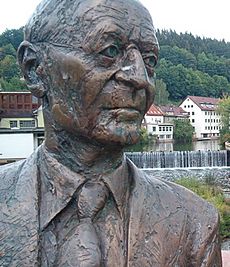
Hermann Hesse was a very popular and important writer in German-speaking countries. His worldwide fame came later. His first big novel, Peter Camenzind, was loved by young Germans who wanted a more "natural" way of life.
His novel Demian had a strong impact on the generation returning from World War I. Similarly, The Glass Bead Game, with its focus on intellectual life and meditation, appealed to Germans looking for order after World War II.
In the 1950s, Hesse's popularity decreased for a while. However, after his death in 1962, new writings and letters were published. This helped people understand and appreciate his works even more.
In the mid-1960s, Hesse's books suddenly became bestsellers in the United States. His stories about the search for understanding and inner peace, like Siddhartha and Journey to the East, connected with the counterculture movement. From the United States, Hesse's popularity spread globally, even back to Germany. He became one of the most widely read and translated European authors of the 20th century. He is still very popular among young readers today.
The band Santana used a quote from Demian on the cover of their 1970 album Abraxas. The band Steppenwolf also took its name from Hesse's novel.
Hesse's Siddhartha is one of the most popular Western novels set in India. A Hermann Hesse Society of India has been formed to translate his works into Indian languages. The Magic Theatre in San Francisco and the Steppenwolf Theater in Chicago are named after places in his novel Steppenwolf.
Many schools in Germany are named after him. There are also literary prizes, like the Hermann-Hesse-Literaturpreis and the Calw Hermann Hesse Prize, given in his honor. The International Hermann Hesse Society was founded in 2002 on his 125th birthday.
Awards and Recognition
- 1906: Bauernfeld-Preis
- 1928: Mejstrik-Preis of the Schiller Foundation in Vienna
- 1936: Gottfried-Keller-Preis
- 1946: Goethe Prize
- 1946: Nobel Prize in Literature
- 1947: Honorary Doctorate from the University of Bern
- 1950: Wilhelm Raabe Literature Prize
- 1954: Pour le Mérite
- 1955: Peace Prize of the German Book Trade
Books by Hermann Hesse
Novellas
- (1899) Eine Stunde hinter Mitternacht (An Hour after Midnight)
- (1908) Freunde (Friends)
- (1914) In the Old Sun
- (1916) Schön ist die Jugend (Youth is Beautiful)
- (1919) Klein und Wagner
- (1920) Klingsors letzter Sommer (Klingsor's Last Summer)
Novels
- (1904) Peter Camenzind
- (1906) Unterm Rad (Beneath the Wheel or The Prodigy)
- (1910) Gertrud
- (1914) Roßhalde
- (1915) Knulp (also Three Tales from the Life of Knulp)
- (1919) Demian (published under the name Emil Sinclair)
- (1922) Siddhartha
- (1927) Der Steppenwolf (Steppenwolf)
- (1930) Narziß und Goldmund (Narcissus and Goldmund or Death and the Lover)
- (1932) Die Morgenlandfahrt (Journey to the East)
- (1943) Das Glasperlenspiel (The Glass Bead Game or Magister Ludi)
Short Story Collections
- (1919) Strange News from Another Star (originally Märchen) — written between 1913 and 1918
- (1972) Stories of Five Decades (23 stories written between 1899 and 1948)
Non-Fiction Works
- (1913) Besuch aus Indien (Visitor from India)—philosophy
- (1920) Blick ins Chaos (A Glimpse into Chaos)—essays
- (1920) Wandering—notes and sketches
- (1971) If the War Goes On—essays
- (1972) Autobiographical Writings (including "A Guest at the Spa")—collection of prose pieces
Poetry Collections
- (1898) Romantische Lieder (Romantic Songs)
- (1900) Hinterlassene Schriften und Gedichte von Hermann Lauscher (The Posthumous Writings and Poems of Hermann Lauscher)—with prose
- (1970) Poems (21 poems written between 1899 and 1921)
- (1975) Crisis: Pages from a Diary
- (1979) Hours in the Garden and Other Poems (written during the same period as The Glass Bead Game)
Film Adaptations of His Works
- 1966: El lobo estepario (based on Steppenwolf)
- 1971: Zachariah (based on Siddartha)
- 1972: Siddhartha
- 1974: Steppenwolf
- 1981: Kinderseele
- 1989: Francesco
- 1996: Ansatsu (based on Demian)
- 2003: Poem: I Set My Foot Upon the Air and It Carried Me
- 2003: Siddhartha
- 2012: Homecoming
- 2020: Narcissus and Goldmund
See also
 In Spanish: Hermann Hesse para niños
In Spanish: Hermann Hesse para niños




